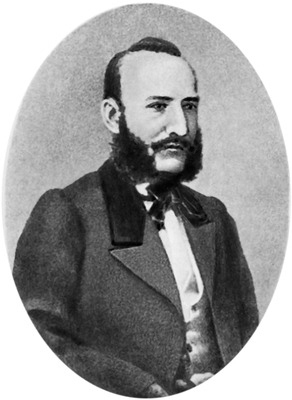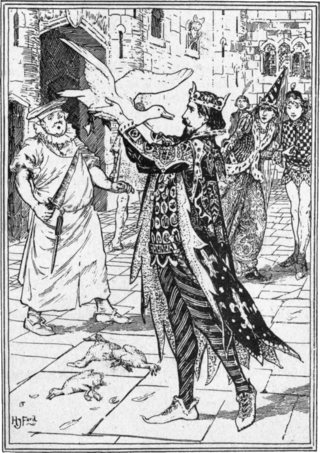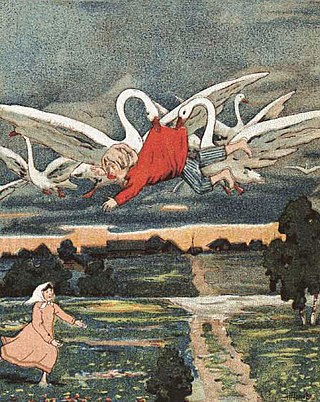This article needs additional citations for verification .(November 2015) |
Vasilisa the Priest's Daughter (Afanasyev 131-133) is a Russian fairy tale collected by Aleksandr Afanasyev in Narodnye russkie skazki . [1]
This article needs additional citations for verification .(November 2015) |
Vasilisa the Priest's Daughter (Afanasyev 131-133) is a Russian fairy tale collected by Aleksandr Afanasyev in Narodnye russkie skazki . [1]
A daughter of a priest wore men's clothing, rode horses, and could fire a gun. One day, the king saw this "young man". But his servants insisted that the "young man" was, in fact, a girl. The king did not believe the servants; he wrote to the priest asking him if his "son" could have dinner with him. The priest sent his daughter to the king’s home. Before she arrived, the king sought advice from a witch regarding the true identity of the "young man". The witch advised the king to do many different things to test if Vasilisa is a girl or not, such as place an embroidery frame and a gun positioned on a wall and to see which object she will notice first. If she is a girl she will notice the frame first, and vice versa. The "young man" passed every test, but the king remained doubtful. The king tries several times to find the true identity, but on the last time the king asked the "young man" to take a bath with him, and the "young man" agreed. While the king undressed, the "young man" undressed, bathed quickly and fled, leaving a note for the king saying
"Ah King Barkhat, raven that you are, you could not surprise the falcon in the garden! For I am not Vasily Vasilyevich, but Vasilisa Vasilyevna" (Afanas’ev 133).
The woman disguised as a man is found in other fairy tales, such as Belle-Belle ou Le Chevalier Fortuné , by Madame d'Aulnoy, Costanza / Costanzo , by Giovanni Francesco Straparola, The Three Crowns by Giambattista Basile and Fanta-Ghiro the Beautiful , by Italo Calvino.

The Tale of Tsar Saltan, of His Son the Renowned and Mighty Bogatyr Prince Gvidon Saltanovich and of the Beautiful Swan-Princess is an 1831 fairy tale in verse by Alexander Pushkin.

In Slavic mythology and folklore, the Firebird is a magical and prophetic glowing or burning bird from a faraway land which is both a blessing and a harbinger of doom to its captor.

The Frog Princess is a fairy tale that has multiple versions with various origins. It is classified as type 402, the animal bride, in the Aarne–Thompson index. Another tale of this type is the Norwegian Doll i' the Grass. Eastern European variants include the Frog Princess or Tsarevna Frog and also Vasilisa the Wise ; Alexander Afanasyev collected variants in his Narodnye russkie skazki, a collection which included folk tales from Ukraine and Belarus alongside Russian tales.

"The Twelve Dancing Princesses" is a German fairy tale collected by the Brothers Grimm and published in Grimm's Fairy Tales in 1815. It is of Aarne-Thompson type 306.

Alexander Nikolayevich Afanasyev was a Russian Slavist and ethnographer best known for publishing nearly 600 East Slavic and Russian fairy and folk tales, one of the largest collections of folklore in the world. This collection was not restricted to Great Russia, but included folk tales from what are now Ukraine and Belarus as well. The first edition of his collection was published in eight volumes from 1855 to 1867, earning him the reputation of being the Russian counterpart to the Brothers Grimm.

Vasilisa the Beautiful or Vasilisa the Fair is a Russian fairy tale collected by Alexander Afanasyev in Narodnye russkie skazki.

The White Duck is a Russian fairy tale collected by Alexander Afanasyev in Narodnye russkie skazki. Andrew Lang included it in The Yellow Fairy Book.

The Lute Player, The Tsaritsa Harpist or The Tsaritsa who Played the Gusli, is a Russian fairy tale. It was published by Alexander Afanasyev in his collection Russian Fairy Tales, as number 338. Andrew Lang included it in The Violet Fairy Book (1901).

"Udea and her Seven Brothers" is a Northern African (Libyan) fairy tale collected by Hans Stumme in Märchen und Gedichte aus der Stadt Tripolis. Scottish novelist Andrew Lang included it in The Grey Fairy Book.
Belle-Belle ou Le Chevalier Fortuné is a French literary fairy tale, written by Madame d'Aulnoy.

Russian Fairy Tales is a collection of nearly 600 fairy and folktales, collected and published by Alexander Afanasyev between 1855 and 1863. The collection contained fairy and folk tales from Ukraine and Belarus alongside Russian stories. In compiling the work, Afanasyev's editing was informed by the German Grimm's Fairy Tales, Slovak tales collected by Pavol Dobsinsky, Bozena Nemcova's work, Vuk Karadzic's Serbian tales, and other Norwegian, French, and Romanian research.
The Wicked Sisters is a Russian fairy tale collected by Alexander Afanasyev in Narodnye russkie skazki.

The Magic Swan Geese is a Russian fairy tale collected by Alexander Afanasyev in Narodnye russkie skazki, numbered 113.
"The Bold Knight, the Apples of Youth, and the Water of Life" is a Russian fairy tale collected by Alexander Afanasyev in Narodnye russkie skazki. The tale and is variants are numbered 171-178 in the first volume of the three-volume collection.

"Tsarevich Ivan, the Firebird and the Gray Wolf" is a Russian fairy tale collected by Alexander Afanasyev in Russian Fairy Tales.
The Firebird and Princess Vasilisa is a Russian fairy tale collected by Alexander Afanasyev in Narodnye russkie skazki. It is one of many tales written about the mythical Firebird.
Costanza / Costanzo is an Italian literary fairy tale written by Giovanni Francesco Straparola in The Facetious Nights of Straparola.

Emelya the Simpleton or At the Pike's Behest is a Russian fairy tale collected by Alexander Afanasyev in Narodnye russkie skazki.

Wish of the Fairy Fish is a 2023 Russian fantasy film directed by Alexandr Voytinsky. Produced by CTB Film Company and Studio Globus, the film is an adaptation of the 1913s Russian fairy tale "At the Pike's Behest" by Alexander Afanasyev. The film follows other adaptations of the fairy tale including the 1938 live-action feature-length film and the 1957 animated short film of the same name filmed in the Soviet Union. The role of Emelya was embodied by Nikita Kologrivy, the Magic Pike was voiced by Mila Ershova, the Tsar declared by Roman Madyanov, and Koshchei was played by Fyodor Lavrov. Other roles include Alina Alekseeva, Yuri Kolokolnikov and Agrippina Steklova. The principal photography took place in various locations, such as Saint Petersburg, the city of Perm, and the town of Tobolsk, Tyumen Oblast.
The Girl as Soldier is a Russian folktale collected by Russian folklorist Ivan Khudyakov, originally titled "Опять Сноха". The tale features a heroine that masquerades her gender by adopting a male disguise, passing by tests designed to discover her gender, and is later kidnapped by her lover ; her lover's mother then forces the heroine to perform difficult tasks for her.